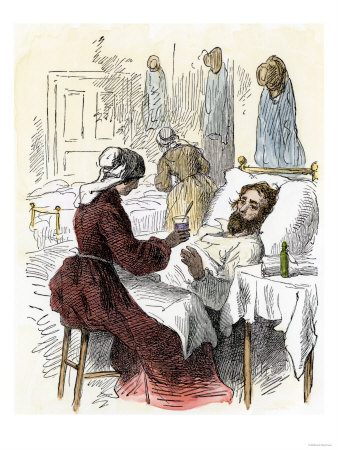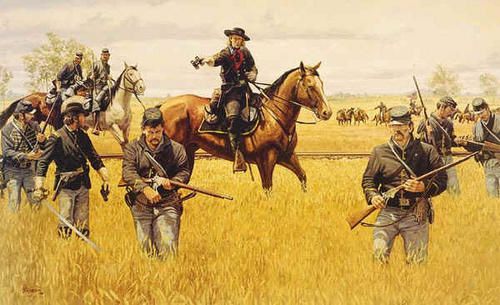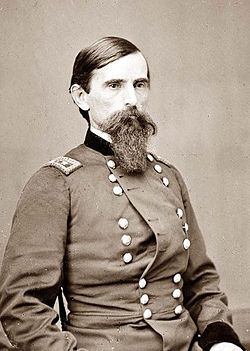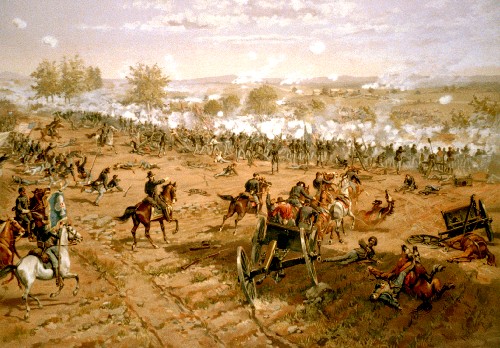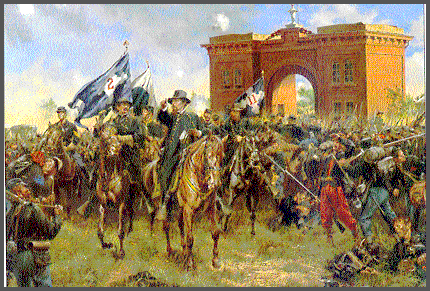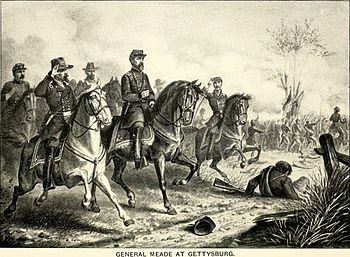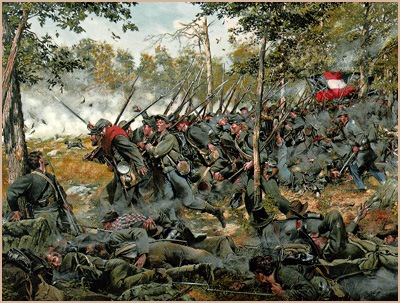Chapter Seventy-Four
The Battle of Gettysburg
Day Three
From "The Battle of Gettysburg" by Jed Bradshaw
Penn State 2005
"Throughout the evening and following morning, most of the remaining infantry of both armies approached the field. Of Jackson’s Corps Lee would have the divisions of A.P.Hill and Ewell available come the dawn with Field and Early not far off. On the Union side Reynolds’ wing was on the road from Taneytown, and both Williams’ XII Corps and von Steinwehr’s XI Corps would arrive at Meade’s headquarters shortly after dawn. Reynolds had ridden through the night to find Meade’s HQ and assume command. Andrew A. Humphrey was left in command of his own V Corps and Stevens’ IX with orders to come up as quick as possible as the day progressed…"
From “The Gray Fox – Robert E. Lee” by R. Southey-Freeman
Orange & West 1958
"At around 7am Allegheny Johnson would open the attack on the Federal right. With his four divisions he was to attack the Federal troops on Cemetery and Culp's Hill, and seek out the flank and if possible turn it.
This was not however the main thrust of Lee’s attack. Instead it would be the first move of an attack in en echelon along the whole line. As Johnson seized the attention of the Federals, Longstreet’s First Corps would commence his attack, first on the west face of Cemetery Hill and then along the Federal line on Cemetery Ridge – French, Wilcox, Anderson and Hood with Pickett in reserve. Finally Jackson’s divisions on the field would move on a tight front towards the Trostle Farm and the two hills beyond, which would dominate the Taneytown Road and perhaps even sever it, thus cutting off Meade…
However Lee understood the potential flaws in his plan. He still believed he outnumbered the Federals but he knew his intelligence was “patchy” at best. Stuart’s orders were to extend both flanks to seek out intelligence on Union numbers and location. Lee had no idea that morning that Reynolds’ Wing was already partially on the field…
However Lee understood the potential flaws in his plan. He still believed he outnumbered the Federals but he knew his intelligence was “patchy” at best. Stuart’s orders were to extend both flanks to seek out intelligence on Union numbers and location. Lee had no idea that morning that Reynolds’ Wing was already partially on the field…
We know from the testimony of Walter Taylor that Lee had sought counsel from his corps commanders that night. The pugnacious Edward Johnson was in favor of an attack but either upon the flank beyond his current position (i.e. on Wolf Hill) or on another front. Johnson was not so aggressive as to have missed “
the formidable nature of the ground” before him. General Longstreet was also somewhat reluctant. “
General Longstreet was willing to make the attack because of our supposition that there were but three Federal Corps before us. But if the Federals had concentrated Longstreet was adamant that the army should not then attack”…
One must remember in judging Lee’s later decisions that his army had known bold successes in the Peninsula and at the Blackwater, but otherwise had met reverses at the hands of the Army of the Potomac when it could concentrate its superior numbers against Lee’s troops…"
From "Always The General - The Life of John Fulton Reynolds" by Jed Bradshaw
Penn State 1999
“Reynolds himself did not sleep but an hour that night, between riding to find Meade, and then riding the ground as best he could in the dark. Reynolds had ordered Williams to take his corps and place it on Hancock’s left, on the southern end of Cemetery Ridge, as the morning progressed. As Reynolds did not yet feel confident in either the ground or the likely rebel line of attack, if any come the morning, he held von Steinwehr in reserve behind the Ridge. Von Steinwehr described his location as the “
bridge between the two legs of the letter A” – the legs being the Union positions on Cemetery Ridge and Wallace’s refused position on the two hills. However if Meade’s and Buford’s description of the position was accurate, “
Lee would be fool to attack with serious intent” come the morning…”
From "The Battle of Gettysburg" by Jed Bradshaw
Penn State 2005
"Attacks on the Union right flank
Union breastworks on Culp's Hill
About 7.00 am the Third Corps' attack began with an assault by D.H.Hill on the northern face of Cemetery Hill. Led off by Doles’ and Garland’s brigade, Hill did little more than demonstrate which reflected both his orders and his view of the strength of Union position before him. Mott’s division of II Corps holding the position was not troubled by the attack. Indeed even this demonstration was an easy target for Union artillery…
Posey's Mississippi Brigade made some gains at the foot of Culp's Hill
The attack by Rodes on Culp's Hill got off to a late start. Most of the hill's defenders, Wallace’s IV Corps (Meade had not returned to his corps but instead remained at HQs with Reynolds), had dug in. Wallace’s insistence on constructing strong defensive works, perhaps a lesson learned from the desperate experience of his comrades at Shiloh, meant that, even depleted by the previous day’s fighting, the five brigades that made up Newton’s I and Barlett’s II division had no difficultly holding off the Confederate attackers. However Posey’s Mississippians did capture a portion of some forward Union works on the lower part of Culp's Hill abandoned by the inebriate Colonel William Harrow, who was relieved later that day by General Wallace and placed under arrest…
Wallace’s III division, formerly his own, now under Duryee’s command had been positioned on the southern portion of Culp’s Hill opposite a stream and Spangler’s Spring. It was here that Johnson set the division of Isaac Trimble to the attack. Trimble was an aggressive, if simple, commander. He attacked a position, every position, head on. Johnson described him as “a terrier with a vice-like jaw. He would hold onto the enemy and shake it til one or both were exhausted or defeated”. Fighting was fierce on this portion of the battlefield. As Trimble’s 3 North Carolina brigades attacked head on, it was Dick Garnet and his Virginians that sought out the extreme right of the Union army…
Colonel Edward E. Cross of the Union army would win plaudits that day for his refusal of his brigade’s right flank and his repulse of Garnet’s attacks…
General Meade and staff preparing for the third assault on Wolf Hill
The critical move of the day, unknown to Lee, was Evans advance on Wolf Hill. Though obvious to Wallace from his elevated position, he had no spare troops to secure his flank. Yet if Evans proceeded beyond Wolf Hill, no doubt leaving artillery up there, he could descend into the rear of the Union position. Wallace sent urgent messengers to Reynolds and Meade alerting them of the danger…
The timely warning brought forth George Meade himself at the head of Von Steinwehr’s XI Corps. Meade knowing the ground better than most at headquarters and keen to aid his own Corps rushed to their relief. Evans' division had already crested Wolf Hill as the XI Corps reached it foot at McAllisters Mill. In order to remedy this potential disaster Meade himself direct the leading division, Barlow’s, to the attack as von Steinwehr readied Webber’s and Schimmelfennig’s…
Casualties in Barlow’s Division were high as they contested the crest with Evans. Underwood’s brigade collapsed and raced down the hill through Devens’ brigade as it came up in support. As Barlow’s division withdrew, the attack was taken up by von Steinwehr’s “Dutchmen” – the brigades of Krzyzonowski, von Gilsa and von Amsberg. These Germans pushed back Evans’ South Carolinans but were flanked themselves as Evans committed his reserve – his sole brigade of North Carolinans under James Johnson Pettigrew. Against this threat, and as von Steinwehr steadied his Germans, Meade against led the rallied brigades of Devens (of Webber’s Division) and McLean (of Barlow’s) against Pettigrew. This counterattack succeeded. Evans could not maintain his attack nor indeed his position atop Wolf Hill under the pressure of XI Corps. However the success of XI Corps was marred by the wounding of General Meade. Having taken a wound to his arm in the first assault, he then sustained gunshot wounds to his stomach and left leg. Carried from the hill only after hearing from Barlow that the hill had been taken, Meade died before he reached the surgeons…
Pettigrew's attack on the XI Corps' flank
Attacks on the Union left flank
As Longstreet’s attack developed, or as Henry Hunt described it “
slammed” into Birney on Cemetery Hill and Hancock on the ridge, Reynolds enquired if Hancock required assistance. “
Not today General” was Hancock’s nonchalant reply…
Longstreet anticipated that at the very least Hood’s attack would “
hit air” as it overlapped the left flank of the Union army. As Hood’s attack went in, the last of Longstreet’s front line divisions, at some time between 10 and 11am, Hood was surprised to find Yankees rushing into positions before him. “
General I find the banners of the XII Corps on the ridge before me, a corps I know was not in yesterday’s fight” is supposed to have been Hood’s message to Longstreet. The cautious Longstreet had his forces slowly disengage and withdraw to their starting positions to prepare…for what? Longstreet was not specific. However the Corps artillery opened a telling fire on Williams’ position from some higher ground but 200 yards from the Union position on Cemetery Ridge…
Alpheus Williams rushes his corps into place on Cemetery Ridge
That Union reinforcements had arrived was obvious. That Longstreet had disengaged was an established fact that Lee could not challenge before it was effected. Lee’s plan was unraveling. Furthermore initial reports from the Confederate left suggested that Johnson’s attack was not gaining much traction…
Forestalling Jackson’s attack, Lee rode with Longstreet and sought out his Second Corps commander. Should the attack continue. Longstreet said no. They had but supplies for one more big fight and it should not be spent on an attack on a likely numerically superior force entrenched on good ground of its own choosing. Lee knew very well that Johnson would likely favor pursuing their attack in some revised form in the current position. But what of Jackson who had just seen the ground and to whom the right flanking attack would fall, what would he favor? Again we have only Taylor’s testimony to rely upon. Jackson did not favor an attack on the heights or on the flanks of the army's current position. It had the look of a natural fortress. Instead he suggested a move of the whole army around the enemy’s right flank. A grand flanking manoeuver. With the Army of Northern Virginia between Washington and its primary army, Reynolds would have to attack them. Was that not General Lee’s intention all along? Longstreet, placing a hand on Stonewall’s shoulder warmly the sentiments and the plan…
Lee and Longstreet listen to Jackson's assessment
Robert E. Lee was an aggressive commander. One but has to look at his record in the Peninsula, at the Rappahannock an at Blackwater to understand that. Yet he also knew his army was not invincible. Since the advent of Phil Kearny the Army of Northern Virginia had received as many whippings as it had dealt out. The Union position at Gettysburg was formidable and Lee knew he simply did not have the intelligence about the Union numbers or position to attack in the knowledge of superiority…
Lee halted Jackson’s attack and sent urgent word to Edward Johnson to draw off from his. By 2pm the fighting at Gettysburg had died down. Reynolds was mystified. The fighting on the Union right had been vicious and extremely perilous to the Union position. Now the Confederates had withdrawn to their starting positions. Sickles recommended a counterattack but Reynolds discounted that for the moment. He would wait and see what Lee was up to. The delay allowed Humphreys and Stevens to get into position…”
From "The Lessons of the Civil War" by Professor Martin Edgars
Hutchinson Press 1975
"In the first years after Gettysburg many rebels saw the attack on Wolf Hill as a lost opportunity. Braxton Bragg would later accuse the commanders of the Army of Northern Virginia of "
timidy" and "
a collective lose of nerve". Evans alone had almost broken into the rear of the Union line. Had Longstreet continued his attack, committing Pickett, in conjunction with Jackson's attack then perhaps the Union position might have been "
pinched off" to borrow the words of Evans himself. That position does not however stand up to assessment in the opinion of modern scholars...
Jackson's attack would not have found a lightly guarded flank. Williams' corps held the southern end of Cemetery Ridge, and the crucial point ignored by many early assessments of the battle, Andrew Humphreys had spotted the value of both the hills at the southern edge of the ridge - Big and Little Round Top. Far from Jackson sweeping over this terrain with the only two divisions of his yet on the field, he would have instead run into John Barnes' Division on Little Round Top and George Sykes' regulars on Big Round Top, with the third division of Samuel Crawford coming up in reserve...
Furthermore Reynolds, in his interior position, had a further reserve following the deployment of von Steinwehr's Corps in the form of Stevens fast arriving IX Corps. Battered though it might be...
Confederate dreams about victory at Gettysburg are just that, dreams...
However the subsequent flanking manouver by Lee's army in the face of the entire Union army is deserving of the study it has received. Strategically wise; tactically well executed; it was a masterclass in battlefield deceit..."
